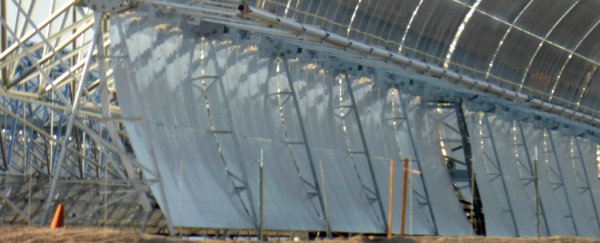Morocco is set to become one of the world's leading suppliers of solar energy, when the first phase of an ambitious concentrated solar plant kicks off next month.
The Noor Solar Project, being built just outside the Saharan city of Ouarzazate, will help provide almost half the country's energy by 2020 when its four phases are scheduled to be finished, and it will also contain hydro and wind energy systems. But what's really exciting about the plant is that it will be able to provide renewable energy even after the Sun's gone down.
Concentrated solar power involves using huge amounts of mirrors to reflect sunlight onto a small area, allowing the Sun's energy to heat up a solution that can later on be mixed with water - even hours after sunset - to create steam that turns energy-generating turbines.
On its own, Noor 1, the first phase of the project, will be capable of generating up to 160 MW of electricity when it launches next month, and the technology it currently uses can store solar energy for 3 hours after the Sun's stopped shining - well past the peak energy demand time of 5pm.
The next two phases will kick off in 2017, and the entire project is predicted to produce 580 MW at peak when it's finished in 2020 - enough to power a million homes, and alongside wind and hydro sources, it's expected to produce almost half the country's electricity.
As you can imagine, the plant's cost a considerable US$9 billion to setup, but the ultimate goal is to use this energy, in conjunction with wind and hydro energy, to wean the north African country off external energy sources. And not only is that good for the environment, it's also a lot cheaper.
"We are not an oil producer. We import 94 percent of our energy as fossil fuels from abroad and that has big consequences for our state budget," Hakima el-Haite told Arthur Nelson over at The Guardian. "We also used to subsidise fossil fuels which have a heavy cost, so when we heard about the potential of solar energy, we thought; why not?"
Noor is being built just outside Ouarzazate, a city that's previously been used to film Game of Thrones, Lawrence of Arabia, and The Mummy, with its biggest draw-card to the film industry being the huge stretches of photogenic sandy desert on offer.
That's also why the Noor solar station is being built there. When all four phases are finished, Noor will take up a footprint bigger than Morocco's capital city, Rabat. Noor 1 alone covers 6,178 acres of land, with 500,000 crescent-shaped solar mirrors located in 800 rows.
The curved mirrors are each 12 metres high and laid out in different tiers, to minimise the amount of damage caused by desert sandstorms. They'll automatically track the Sun as it crosses the sky to reflect every last ray of sunlight, bouncing it back onto a steer pipeline carrying 'heat transfer solution'.
The solution is made up of a synthetic thermal oil blend, which is heated to temperatures of up to 393 degrees Celsius by the concentrated sunlight. At this point, it's pumped to a heat tank containing molten sands that are capable of storing the thermal energy for 3 hours.
Technicians have told The Guardian that by 2017, when Noor 2 and 3 launch, the heat tanks will be able to store this energy for an unheard-of 8 hours, which means the plant will be able to power the surrounding area with solar-generated electricity throughout the night. "We are very proud of this project," said el-Haite. "I think it is the most important solar plant in the world."
But the plans don't end there. El-Haite has expressed his desire to eventually move Morocco to complete self sufficiency, including water desalination plants. He also wants to begin sharing their renewable energy resources with other countries in the Middle East and Europe.
We can't wait to see what happens when the first phase of Noor officially kicks into gear. It's about time we started using some of that unharnessed sunlight in the Sahara Desert to make the world a better place.
